How to make wooden marker poles
At the beginning of October we were looking for marker poles to help a friend mark his property limits. Those poles are usually 4x4 which means 4 inches wide and thick. It is basically the same as a fence post. Around here people look for some tropical hardwood that doesn’t rot in direct contact with the soil and is resistent to insect attacks. There are a lot of termites around here.
If you ask around for a good wood species for fence posts, the answer usually is “nispero”. Nispero is called bulletwood in English. But you have to find a tree first, because you cannot go into a store and buy a few ready to use fence posts or marker poles made of nispero.
We found an already fallen guayacan tree. Here you can see Luis and Carlos standing on the tree. Carlos is a friend and owner of the farm where the tree was standing. Guayacan is very hard wood. So hard that you cannot drive a nail into it. You have to drill holes and use screws. The wood is very dense and heavy.
<div style="text-align:center;"> </div>
</div>
It is said that guayacan is equally resistent than nispero and a few other species used for in direct contact with soil applications. So a few days later we came back with our equipment.
<div style="text-align:center;"> </div>
</div>
Rails, a tank of gasoline and our big Stihl MS650 chainsaw. The saw weights about 8 kg and Moises who is carrying it is a heavy guy - great chainsaw operator. He can swing that thing a whole day - 8 hours straight.
<div style="text-align:center;">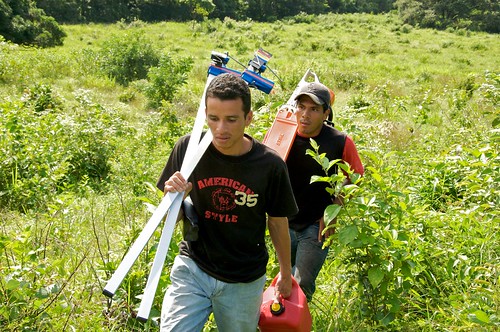 </div>
</div>
Luis brings the final piece of equipment to the worksite. This is an Alaskan Mark III chainsaw mill.
<div style="text-align:center;">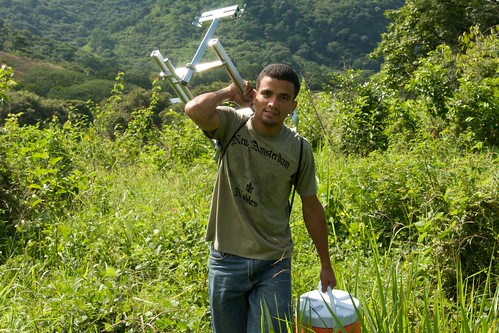 </div>
</div>
There is the other end of the guayacan tree’s trunk. It is thick!
<div style="text-align:center;">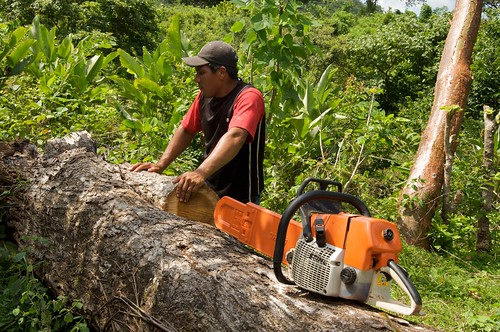 </div>
</div>
Moises is filling up gasoline and oil and checking the chainsaw. Notice how he already sweats. It was only around 9:30 AM.
<div style="text-align:center;">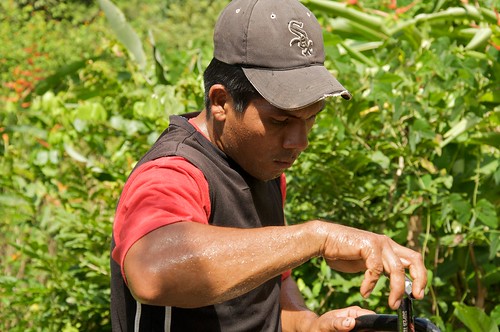 </div>
</div>
As a warm-up Moises is cutting off a smaller branch off the big trunk …
<div style="text-align:center;"> </div>
</div>
… and then moves on to the actual trunk. It is thicker than the chainsaw’s blade is long so he has to cut it from different sides.
<div style="text-align:center;">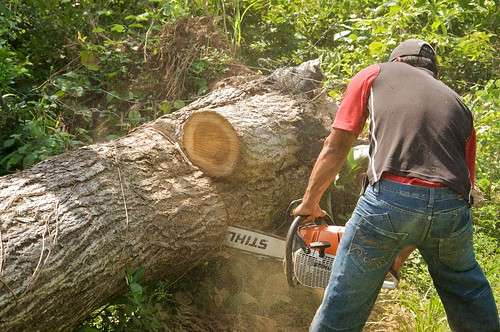 </div>
</div>
After the trunk has been cut into pieces they get moved in a position where the rest of the work can be done easier. The logs have the length of the marker poles we want to make. As I said in the beginning guayacan wood is heavy - it shows.
<div style="text-align:center;"> </div>
</div>
Here Moises is cutting slices to find where the trunk doesn’t have this beehole anymore. You see that hole in the trunk. That’s called a beehole. Of course there are no bees in the trunk but as soon as it is exposed they do come and want to settle in there.
<div style="text-align:center;"> </div>
</div>
| Previous | 23 Nov 2009 | Next |
This article has been posted to social media sites. There might be comments. Just follow the links:








